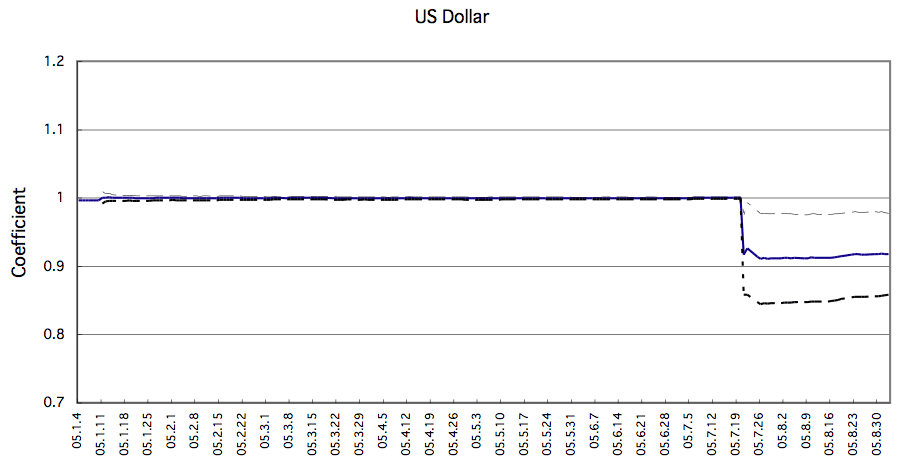On July 21, 2005, the Chinese government revalued the yuan by 2.1% against the U.S. dollar. Together with this revaluation, it also announced it would shift its exchange rate system from a traditional dollar peg to a "loose" currency basket system, under which it would refer to a selection of multiple currencies when implementing exchange rate policies. The governor of the People's Bank of China revealed that this currency basket is essentially comprised of the dollar, the euro, the yen and the Korean won, taking into consideration such factors as trade, capital transactions (external claims and debts) and direct investment. The authorities have also adopted a narrow band of 0.3% on either side of the central rate within which the yuan is allowed to fluctuate against the dollar. While the yuan's revaluation this time was a scant 2.1%, this is an important policy decision in that it comes hand in hand with reforms to China's exchange rate regime.
Significance of the exchange rate system reforms
A shift to a flexible exchange rate regime, especially the adoption of a currency band that refers to a basket of currencies, provides monetary authorities with a certain degree of freedom in independently implementing policies that would have been restricted if a dollar peg system had been maintained amid the free movement of capital. China needs greater exchange rate policy flexibility considering that domestic monetary policy management will become increasingly important in the near future as capital flows are liberalized and China begins to deal with the overheating of the economy in advance of the Beijing Olympics, and the economic downturn expected to follow.
In addition, Malaysia's shift from a dollar peg to a currency basket system at the same time as the reform of China's exchange rate system is proof of the extent to which the Malaysian government was affected by China's exchange rate policies. As this shows, China's exchange rate policies influenced its East Asian neighbors, and because these countries failed to coordinate their exchange rate policies, all East Asian nations tended to adopt policies that placed excessive weight on the dollar. If China's exchange rate regime becomes more flexible, then this situation of coordination failure can be eased to a certain extent. The undervaluation of the yuan becomes obvious upon viewing "AMU and AMU Deviation Indicators" on RIETI's Website.
So then, were there actually any changes in China's exchange rate policy after July 21? While there were some slight fluctuations, the exchange rate has remained basically flat at around 8.11 yuan to the dollar, the level it rose immediately after the revaluation. Compared to the situation prior to revaluation in which there had been absolutely no fluctuation in the exchange rate, while there has been a slight change from 8.11 to 8.09 yuan to the dollar, we have yet to see the rate move greatly away from the post-revaluation level.
If the composition of the currency basket to which the exchange rate policy is said to refer is adopted from the viewpoint of trade, we need only to look at the respective shares of China's trade held by its trading partners. In the composition ratio (2004 figures) of China's trading partners and their trade volume (exports plus imports), the United States comprises 14.7%, Japan 14.5%, the European Union 15.4% and South Korea 7.8%, with the remainder made up of other countries, including all East Asian nations except Japan and South Korea. Even if we were to add the remaining countries to the dollar share for our calculations, the composition of the currencies in the basket would be roughly 62% U.S. dollar, 15% yen, 15% euro and 8% Korean won.
Emancipation from the spell of the dollar peg
Figure 1 shows the changes in the correlation between the yuan and the U.S. dollar as calculated by Michiru Sakane and the author for RIETI Faculty Fellow Takatoshi Ito's research project, "The Optimum Exchange Rate Regime for East Asia." Daily foreign exchange rate data were used for these calculations, and to show the regression coefficient's changes over time a figure was created that shows the changes in the estimated value of the dollar's coefficient after using the Kalman filter to perform a regression on the yuan with the four basket currencies. The solid line shows the estimated value while the dotted lines show the estimated value ± 2 x standard deviation (the equivalent of a 95% confidence interval). As is clear from the figure, there was a statistically significant decline in the correlation between the yuan and the dollar before and after China's currency revaluation and exchange rate regime reforms. The correlation fell from 100% to slightly above 90%. Thus it seems that a statistically significant change is indeed taking place. However, from an economic viewpoint, a decline of this slight nature cannot be said to be a meaningful change. As a result of analyzing the data, the fact is that contrary to what Chinese government announced, monetary authorities have thus far not been referring to the currency basket in implementing exchange rate policy.
Based on these findings, China's exchange rate system reforms have only just begun. The Chinese government needs to unfetter itself from the spell of the dollar peg by easing its restrictions on capital in order to provide the means to control exchange rate risks (such as futures trading) and manage exchange rate policy by truly referring to the currency basket.
Figure 1: Movements in the correlation between the yuan and the U.S. dollar Note) The solid line shows the estimated value, while the dotted lines show the estimated value ± 2 x standard deviation
Source: Ogawa, Eiji and Michiru Sakane, "The Chinese Yuan after the Chinese Exchange Rate System Reform" mimeo, September 4, 2005.



